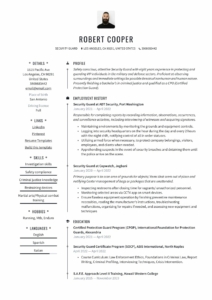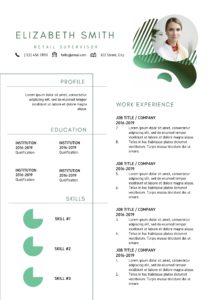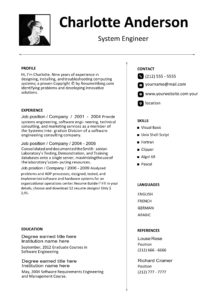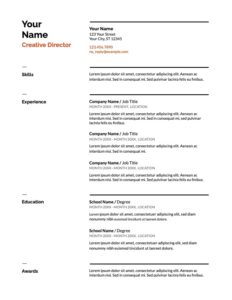Seeking a new job as a Machine Operator? Why don’t you take a look at our Machine Operator resume sample, detailing every aspect to consider when building your own unique resume?
Examples of machinery that operators work with include CNC-, millers-, grinders-, lathes-, drill presses-, roller-, mold injection-, assembling-, cutting-, melting-, stamp machines, and endless other kinds of machinery.
To make a solid and intriguing resume, we recommend beginning to review proven resumes from your field.
In our write-up below, we will explain to you how you make your resume stand out, look up-to-date in today’s standards, and impress hiring managers and recruiters across the board. You will get inspired, and with a resume example in front of your noes, writing goes a lot easier and faster!
What you can read in this article
Machine Operator Resume Samples
(Free sample downloads are at the bottom of this page)
Machine Operator Resume Writing Guide
Resume Sections
- Contact information
- Profile Summary
- Work History
- Achievements
- Education
- Skill Section
- Certification & Licensing
- Extras: Languages/Awards/Publications/Volunteering/hobbies
- > Professional information
1. Contact Information
- First Name and Last Name
- Physical Address
- Driver's license (optional)
2. Career Summary:
Provide a broad overview of your profession, years of experience, and specific areas of specialty. (you are probably skilled in a range of industrial equipment and employers would want to know about that). A career summary is a 30-second elevator pitch to your application, and you need to make it count because that is the only chance to prompt hiring managers to review the rest of your resume application. Keep to one paragraph, including 3–6 sentences.
3. Qualifications/Licenses/Certifications:
List any professional development, licenses, certifications, workshops, or training that you have received. Most employers don’t require Machine Operators to have more than a high school diploma. If you have additional certifications for special machinery, remember to add them in this section to increase your chances for an interview and perhaps a higher pay grade too.
4. Relevant Machine Operation Experience:
Showcase your past places of employment and include a list of your daily responsibilities. If you are new to the operator field, you can add other employment here to show you do already have some work experience. If you have been in the industry for a while, only include your machine operating experience. Stick to the last ten years of working tenure and present your employment history from the most recent backward. If you are a newbie, provide information regarding apprenticeship or in-service training gigs.
5. Skills Summary/Key Skills:
List key skills that you possess that are also found in the job posting. This will reinforce the message that you are technically and physically equipped for the role. Machine Operators also need a variety of interpersonal skills (more on that in our skills section at the end).
6. Languages: Optional:
If you know how to speak multiple languages, include what languages you know and your level of proficiency. This is especially important when looking for work in a region with many foreign workers.
Career Summary (& Example Summaries)

The career summary is vital for two reasons. First, provide an outline for what is to come and prompt the recruiter to review your entire resume. Secondly, a summary is most helpful for impatient hiring managers who only review candidate summaries to make a shortlisting decision without going into the details of the resume.
A surefire way to assure recruiters and hiring managers that you are a fit for the role is to align your career summary to the prerequisites and requirements in terms of technical competencies and interpersonal skills, listed in the job advertisement (if you possess them, of course!). This would also mean that you may need to tailor a different career summary for each of the jobs you are applying to. More effort for sure, but definitely worth the time in interview invites that would be coming your way.
Write your career summary last, after you have compiled the rest of the resume document, and follow the steps below if you get stuck:
- Stick to 3–6 sentences
- Use strong, but descriptive phrases and action verbs
- Steer clear of abbreviations and acronyms
- Break it up into three parts: Job tile and Experience PLUS technical skills and wow factors PLUS credentials and certifications
Examples of Resume Summaries:
Resume Summary 1
Well-tenured Machine Operator with six years of industrial experience in the mining and minerals environments operating, monitoring, and troubleshooting PLC machinery and equipment. Holds a 100% safety and zero machine malfunctioning record for the last six months. Certified as a CNC Technician.
Resume Summary 2
Enthusiastic Apprentice Machine Operator with six months of experience as an in-service trainee at a specialty chemical plant. Well-versed in theoretical and practical fundamentals of raw materials selection and combining compounds per process specifications and precision measurement machining. Currently completing a Roll Form Operator trade certification.
Resume Summary 3
Experienced Machinist with over a decade of employment in operating and programming CNC machines such as lathes and milling equipment for the packaging industry. Extensive coding in PLC and can interpret blueprints and drawings using CAD and CAM software applications. Highly adept at regulating and monitoring machine flow, temperature sensors, and speed gauges for hours on end. Has a Forklift Driver's License and currently pursuing a Diploma in Mechanical Engineering.
What to Highlight in a Machine Operator Resume
As a Machine Operator, you can be working on a variety of machines or only one, and in all types of manufacturing and processing factories. Starting as a Machine Operator usually begins by receiving training on the job from more experienced machinists. Regardless of your experience as a Machine Operator, there are specific aspects to highlight in your resume to assure employers and recruiters that you are technically competent for the vacancy at hand.
Firstly, you need to classify what type of Machine Operator you are. There is an infinitive number of machines out there being used in almost any industry imaginable. However, experience in one kind of machinery can be transferred to another industry, for instance, lathes and milling machines are used in the sugar manufacturing industry as well as the chemical process industry. Use sic codes to ensure that you are referring correctly to the sectors you have gained experience in.
Let’s unpack a few examples of the main Machine Operator categories:
- Packaging Machine Operators work in industrial and retail environments where they operate equipment that prepare products and goods for storage, transport, or shipment. If this is your area, make sure to mention the packing machinery that you can run and if you are also responsible for troubleshooting errors or fixing mechanical issues and problems. You are welcome to also give detail regarding the packing process, for instance, wrapping, palletizing, boxing or automated bagging to explain further what your machinist skills entail.
- Printing Machine Operators are responsible for operating press machines that are used to create gravures, letter presses, and lithography. Explain the nature of your position by using key terminologies evident in the printing sector such as installing printing plates, loading ink to presses, stocking feeders and correcting mechanical errors with ink spreading and paper feeders.
- Heavy Machine Operators work on manufacturing, mining or construction sites and are responsible for operating heavy machinery and equipment. Examples are drilling and boring machines, rolling machines, milling, and planning equipment and injection molding machines. Apart from listing the primary equipment you are familiar with, you should also mention mechanical adeptness regarding maintaining, repairing and cleaning heavy equipment. Specific responsibilities for this role are completing maintenance activities, performing dust control, collecting waste, cleaning equipment, making repairs, and reporting to supervisors.
- SMT Machine Operators are responsible for operating Surface Mount Technology equipment used to assemble large industrial components or join panels. Hiring managers would want to know if you can set and calibrate these machines, if you are skilled at quality inspections and interpreting blueprints and schematics related to precision machining.
Next, provide a little detail regarding your work setting. Are you employed in a factory, processing plant or assembling facility? You may also be working in a warehouse and distribution setting where you are responsible for moving pallets with a forklift machine, for example. Machine Operators can work above ground, for instance at a food manufacturing facility, or take their skills below ground if we think of mining where one would be operating digging and trenching machines. Taking this a step further, Machine Operators are also employed to run underwater equipment, for example, dredging tools that is prominent in offshore oil rig environments.
Now, you need to specify the purpose of your job. In some cases, you may be responsible for purely operating the machine and perhaps basic monitoring and adjustment of settings. In other instances, you could be tasked by reading and analyzing blueprints and sketch designs using CAD or computer-aided manufacturing (CAM) files. Understanding machine setup for the alignment and placement of tools, guides, cutters, and stops is critical to a Machine Operator’s job (if the setup is incorrect, the machine won’t work). Another aspect to mention is if you have experience in manual machinery or automated machinery. Manually operated machines require physical actions such as securing and placing mobile fixtures, compounds or materials on equipment and machinery. Automation machinery, on the other hand, requires operators to oversee moving parts during the production process and adjust speed, timing or frequencies to ensure production and standards accuracy.
Then, include your safety and health knowledge and the policies and procedures you adhere to for ensuring your own safety and the safety of those around you, following industry regulations. For example, the logging of incidents, wearing the appropriate safety gear and even the fact that you know Basic First Aid or Fire Emergency protocols.
Finally, is a paragraph dedicated to your physical capabilities, for instance, being able to lift more than sixty pounds, excellent hand-eye coordination, peripheral awareness, or multi-limb coordination. If you can provide a medical certificate stating a clean bill of health, it would be to your advantage too.
* Resume Hack – To ensure that recruiters can immediately see Machine & Tools include them in table format such as the one below:
Tools & Tech
| Boring Machines | Surface Grinding Machine | Threading Machine | Blow Molding Machines |
| Buffing Machine | Power Buffers | Spot Welding Machine | Water Displacement Machine |
| Cutting Die | Hydraulic Press brake | PLC | Tapping Machine |
| Extruding machine | Lathe Machine | Milling Machine | Metal Broaching Machine |
| Gear Cutting Tool | CNC Machine | Planing Machine | CMM Machines |
| Forklift | Metal Band Sawing Machine | Tube Bending Machine | Deburring Machine |
| Robotic loading equipment | Metal Band Sawing Machine | Turning Machine | Automatic Chucking Machine |
Machine Operator Job Descriptions & Examples
Whether you are just starting out, or are a seasoned Machine Operator, employers are expecting you to be familiar with the basics and what matches your experience and certifications with the requirements of the job spec. Before we get to actual job description examples, have a look at the classification of Machine Operators first, because you need to indicate to employers at which level (career stage) you are currently working.
- Machine Operator I (0 – 1 years experience): Involved in the setup and operation of machines. Use basic computer-controlled equipment to select, place and secure machines. Make minor adjustments to machine settings. Fully supervised.
- Machine Operator II (1 – 3 years experience): Responsible for more complex setup and machine operation, routine inspections and adjustments or resets of positioning, sensors, safety stops, and automatic controls. Works with moderate supervision.
- Machine Operator III (3 – 5 years experience): Controls and adjusts high-level machine settings with calculations and numerically controlled programming activities. Operates complex machinery which may be automatic or semi-automatic and also responsible for complex inspections, troubleshooting, and repairs. Works with little or no supervision.
To make sure your resume is what employers are looking for, try incorporating these job duties where applicable to your experience and technical knowledge:
A General or Beginner Machine Operator may:
- Pull, inspect and verify product before processing
- Perform quality checks during machine operation to ensure proper function
- Complete job responsibilities in a manner that does not put him/her or other individuals in an unsafe situation
- Complete production/productivity logs and reconcile production data
- Perform quality checks during machine operation to ensure proper function
- Provide feedback to supervision regarding machine efficiency and product quality.
- Perform general clean-up
- Properly and safely set up equipment to run material to set up note specifications.
- Perform preventive equipment maintenance
- Assist in the packaging of material per written work instructions and work order
- Capture and remove raw material identification tags per specified instructions
- Select, inspect and verify materials before processing
- Maintain and tweak precision measurement machinery
- Complete all required documentation, logs, reports, and records accurately and send to supervisor at the end of each day
- Adhere to quality standards, safety protocols, and production output targets
- Perform follow up operations such as deburring, polishing and grinding.
- Meet the required production timeframes determined for set up and production cycle times
- Performed basic numerical calculations
An Experienced Machine Operator may:
- Set up, operate, and maintain cranes, forklifts, and other material handling equipment.
- Verify that the product meets set-up note specifications per written work instructions and record measurements (sampling plan)
- Communicate with the appropriate sales representative regarding changes/clarification to orders
- Balance the immediate workload, recognizing when help is needed and when to be the team player to dig right in and assist or direct others
- Properly operate weighing scale and record inspection measurements
- Train others when required
- Assist in any activities related to lean and quality
- Meets TKMNA Employee Attributes / Competencies
- Set up assigned press line for maximum efficiency and productivity
- Performed follow-up operations such as deburring, polishing and grinding
- Adhere to standard production timeframes established for set up and cycle times.
- Perform complex numerical and mathematical calculations
- Fine-tune, tweak, and adjust software from mathematical calculations and metric conversions to ensure precision placing of plates and materials for cutting purposes
- Check materials to ensure the accuracy of size and dimensions
- Maintain and update the logbook of changes to dimensions and set up of program applications to plan and estimate activity targets for each machine
Highlight Your Accomplishments
Under your accomplishment section, you may think that copying job duties from your job description section would suffice just to fill up space. However, accomplishment statements in a Machine Operator resume are just as essential as in any other resume.
Think of accomplishment statements as product components that are assembled with measurable achievements to showcase your technical competencies to prospective employers.
The trick to writing them is adding quantification, as to provide a ‘’proof of work’’ for each claim made. This also shows the hiring manager that you are driven and motivated by results and targets.
It would help if you were answering questions such as, “How much?” or “How many?”. For instance: How many types of machines can you operate, maintain, fix? What is your safety incident rating for the last year? How many products, compounds, materials are processed by the machine that you operate daily, weekly, monthly?
Example Accomplishment Statements
- Perform CNC setups 34% faster than the facility’s average
- Complete logbooks and paperwork with 99% percent accuracy
- Identified a sensor monitoring error which prevented malfunctioning from the machines overheating saving the company ten days in potential downtime to order a new machine
- Suggested an automated calibration approach to the PLC coders which after implementation reduced calibration and measurement time by 80%
- Met stringent deadlines during the holiday season ramping up product output from 10 000 products wrapped in a 24hour cycle to 15 000 products by working extended shifts
- Revamped and overhauled a CNC Machine which saved the company a 100k in replacement cost
- Instrumental in introducing KANBAN preventative maintenance strategies which increased machine lifespans by 82%
Machine Operator Education Section
Machine Operators can secure jobs without having completed any formal education apart from a GED or High School Diploma. The more credentials you can offer prospective employers, the better your chances of landing higher-paying positions. In short, list the What, Where and When regarding your qualifications and certifications: date completed, hours accumulated (if applicable), level attained, institution attended and location.
Here are some examples of a Machine Operator Resume in terms of education:
2017 – CNC Machine Tool Operator Certificate Lincoln Tech, Denver, CO
2017 – Certificate of Achievement on Mastercam, Eastern Kentucky University, Richmond, KY
Subjects Completed: Mill 2D, Mill 3D, Lathes, FBM, WCS, Wire, 4 Axis/ 5 Axis, and Solids
2016 – Advanced First Aid Certificate, American Red Cross, Orlando, FL
2016 – Heavy Equipment Certification, National Center for Construction Education and Research, San Bernardino, CA
Courses Completed: Motor Graders, Excavators and Tractors, Introduction to Blueprints, Heavy Equipment Safety, Basic Operational Techniques
2015 – Certified Production Technician, Manufacturing Skill Standards Council (MSSC), Dallas, TX
Completed five 90-minute assessments achieving an 89% average
2015 – Manufacturing Technician Level 1, Manufacturing Skills Institute (MSI), Reston, VA
2014 – Forklift Driver Certification, Forklift Training USA, Clinton, MI
2013 – Certified CNC Setup Programmer, National Institute for Metalworking Skills (NIMS), Crump, TN
2012 – Precision Sheet Metal Operator (PSMO), The Fabricators & Manufacturers Association (FMA), Elgin, IL
What to Write in a Machine Operator Resume Skills Section
Technical skills and interpersonal skills are equally crucial for a Machine Operator to perform the job successfully. Therefore, ensure that you include examples of both in your Machine Operator Resume Skills Section.
A smart idea would be to visually organize them in a skills matrix also adding your physical traits. In the example below we have included a skills matrix divided into three columns (Physical, Technical, Interpersonal) and then added the ten most important skills under each heading. You may need to tweak and replace the skills you choose to list following those mentioned in the job spec. This will reinforce your message that you would be an excellent fit for the role at hand.
| Physical Skills | Technical Skills | Interpersonal Skills |
|---|---|---|
| Manual Dexterity | CNC Operation | Punctual |
| 20/20 Vision | Kaizen | Trustworthy |
| Hand/Eye Coordination | SMED | Communication |
| Multi-Limb Coordination | Set Up and Tuning | Detail Orientated |
| Endurance | Mechanical Repairs & Maintenance | Team Player |
| Ability to life 70 pounds | Calibration & Measurement Techniques | Energetic |
| Nimble & Agile | Safety Regulations & Quality Control | Self-Managed |
| Depth Perception | Blueprints & Schematics & G-Code | Determined |
| Peripheral Vision | Machine Alignment | Committed |
| Excellent Health | Coding & Programming | Problem Solving |
Qualifications/Certifications associated with Machine Operators
| OSHA Certification | GED | High School Diploma |
| Six Sigma Yellow Belt Certification | CNC Programmer Certification | CNC Machine Operator-Milling |
| Certified Fire Protection Specialist (NFPA) | Certification of Crane Operators (NCCCO) | Associate's degree in Precision Machining |
| CPR | CNC Machine Operator-Lathes | CDL Class A |
| Precision Sheet Metal Operator (PSMO) | CPUT – Certificate In Storemanship | Certified Forklift Driver |
Professional Information on Machine Operators
Sectors: Various
Career Type: Metalworker, Repairman, Coder, Machine Operator, Material Moving Machinist, Injection Molder, Machine Mechanic, Logger
Person type: Worker, Operator, Setter, Calibrator
Education levels: From no formal education to post-school qualifications
Salary indication: $11.43 (Low), $15.57 (Median), $21.12 (High) Payscale
Labor market: Various depending on Industry:
- Machine Operators (Milling, Lathes, CNC) 1% growth from 2016 to 2016 (BLS)
- Construction Machine Operators 10% growth from 2018 to 2028 BLS
- Material Moving Machine Operators 4% growth from 2018 to 2028 BLS
Organizations: Plants, Factories, Production Facilities, Manufacturing Operations, Drop-Shipping Facilities, Retail, Wholesale, Mining, Cargo, Shipping, Utilities, Construction, Commercial, Corporate, Agriculture
Download Machine Operator Resume Examples in PDF
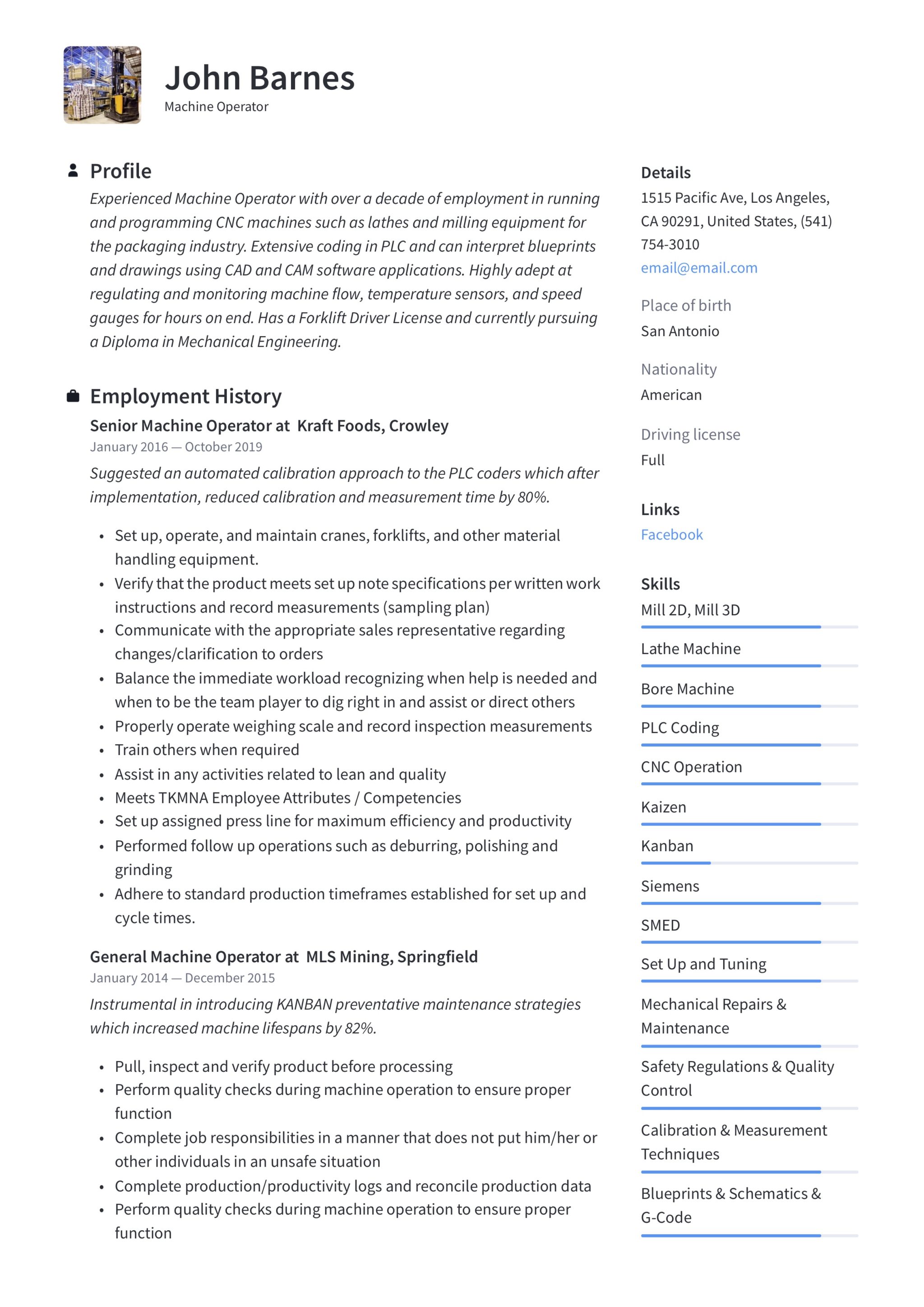
Machine Operator – Resume (0).PDF
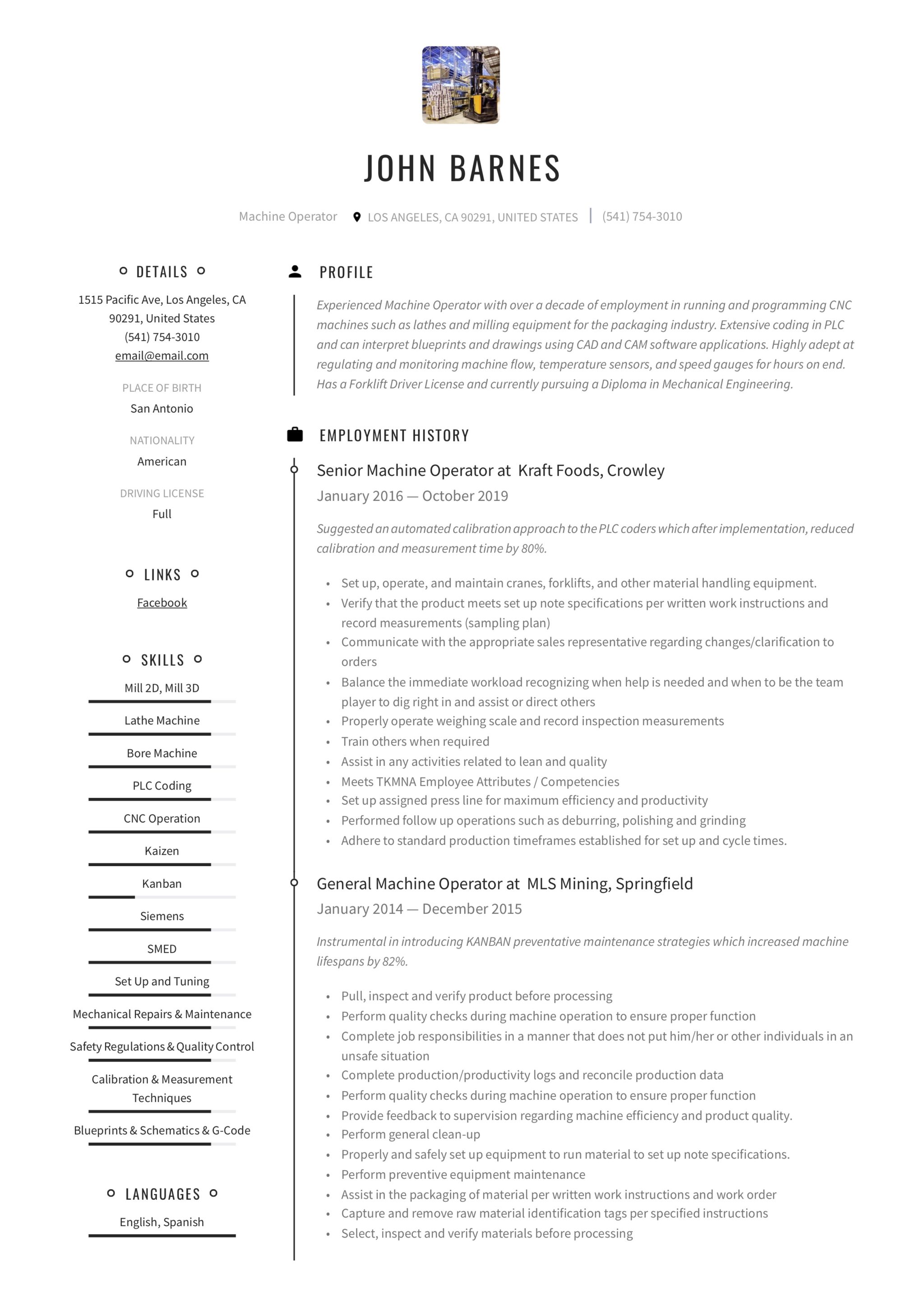
Machine Operator – Resume (1).PDF
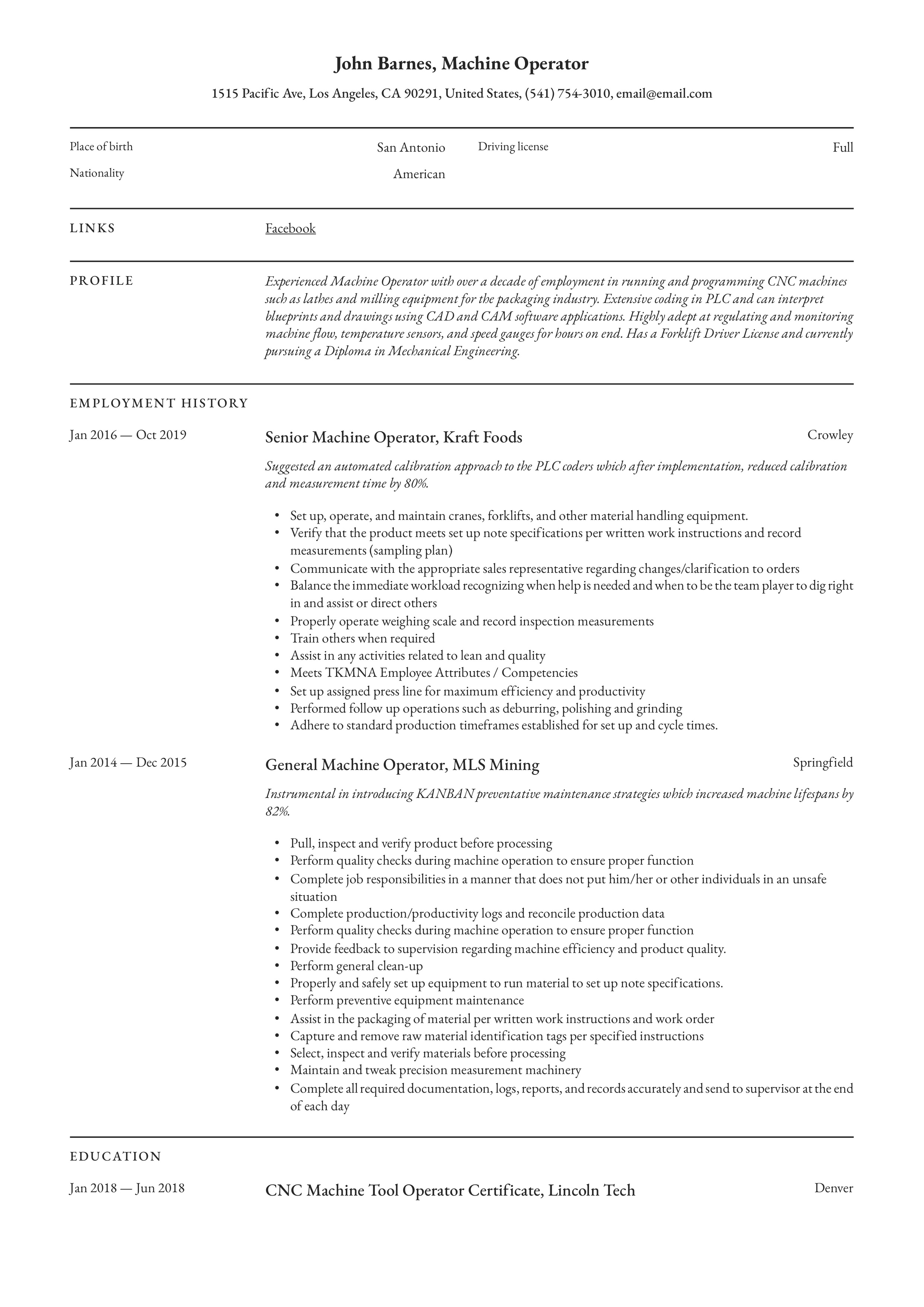
Machine Operator – Resume (2).PDF
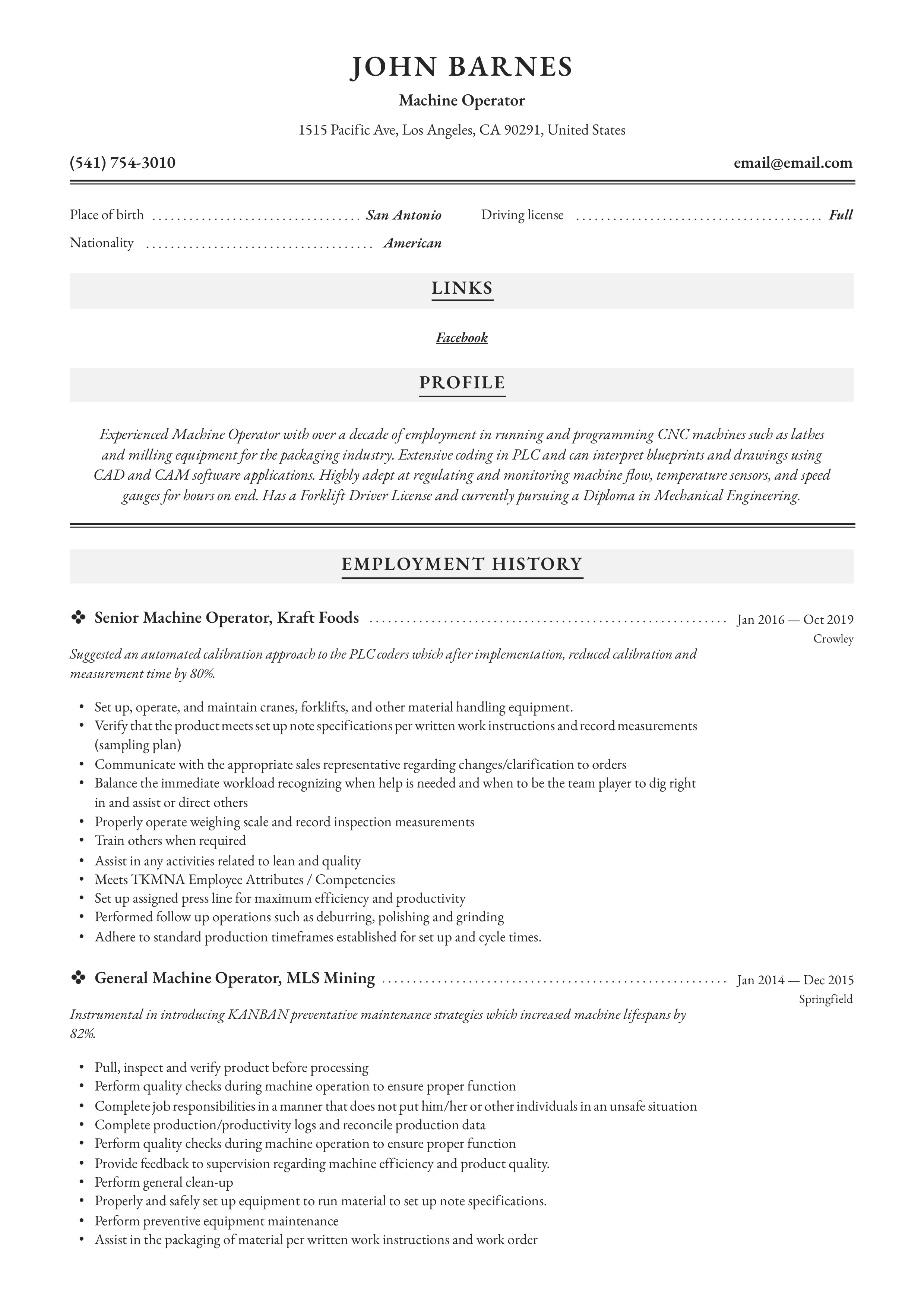
Machine Operator – Resume (3).PDF
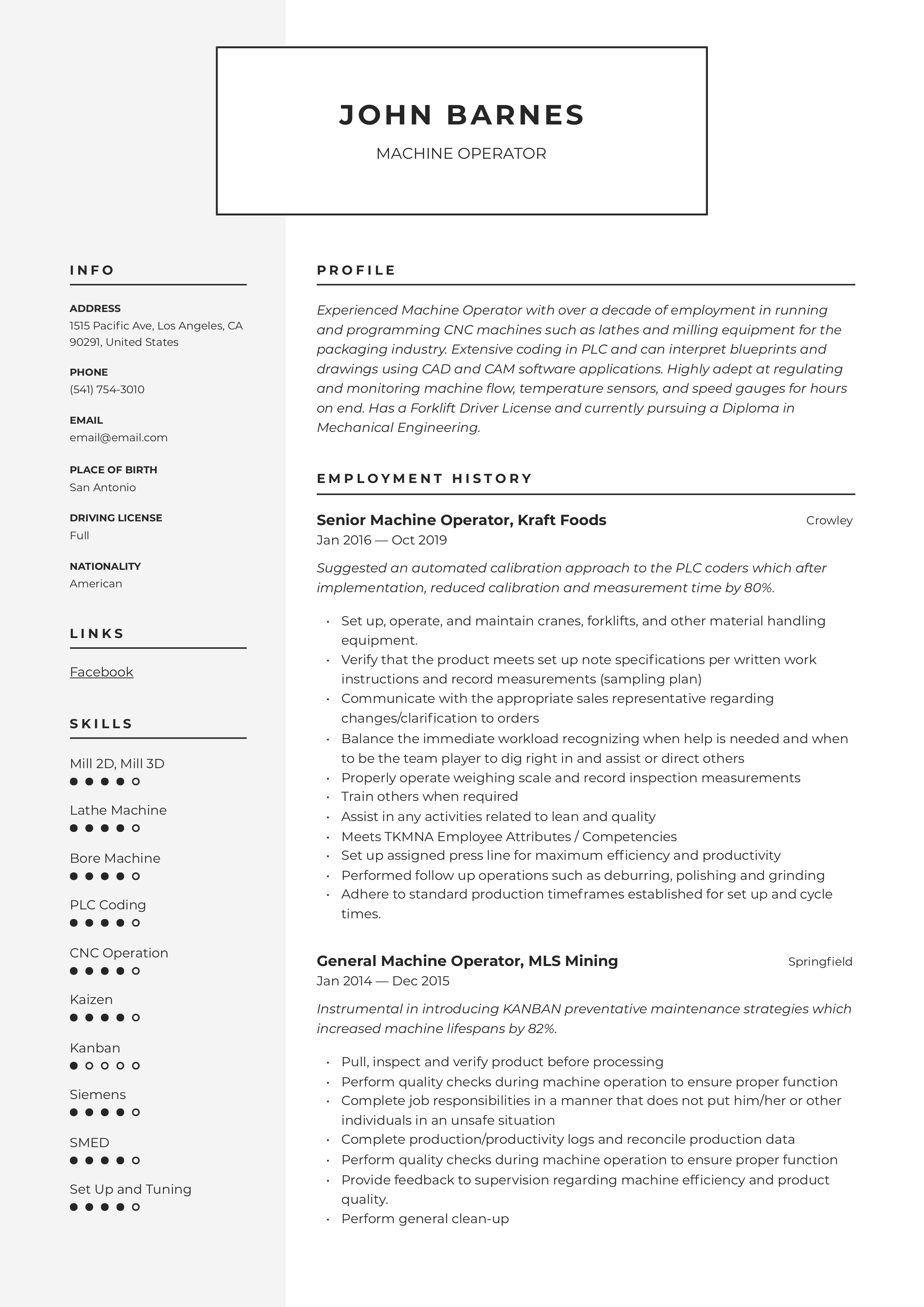
Machine Operator – Resume (4).PDF
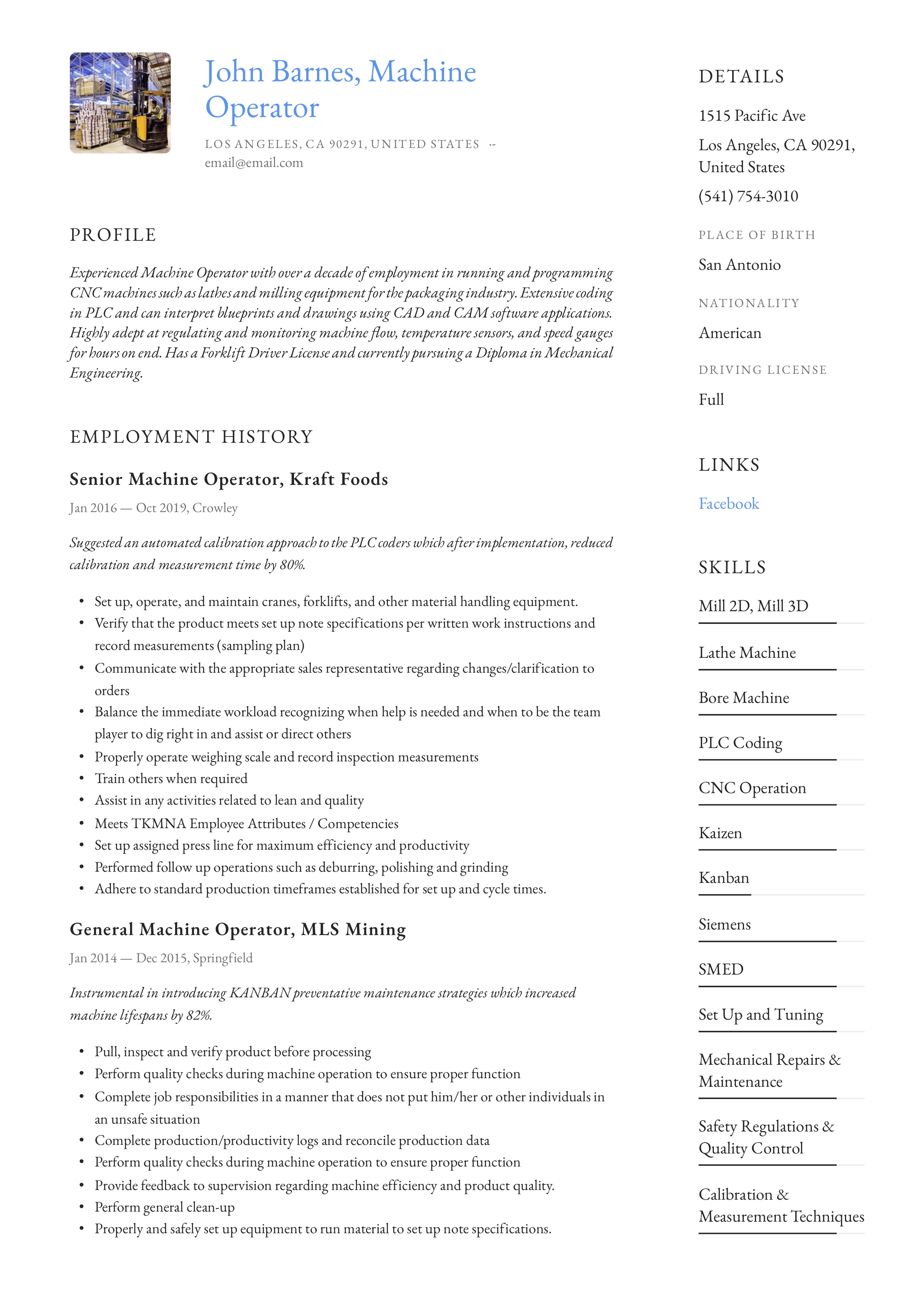
Machine Operator – Resume (5).PDF

Machine Operator – Resume (6).PDF
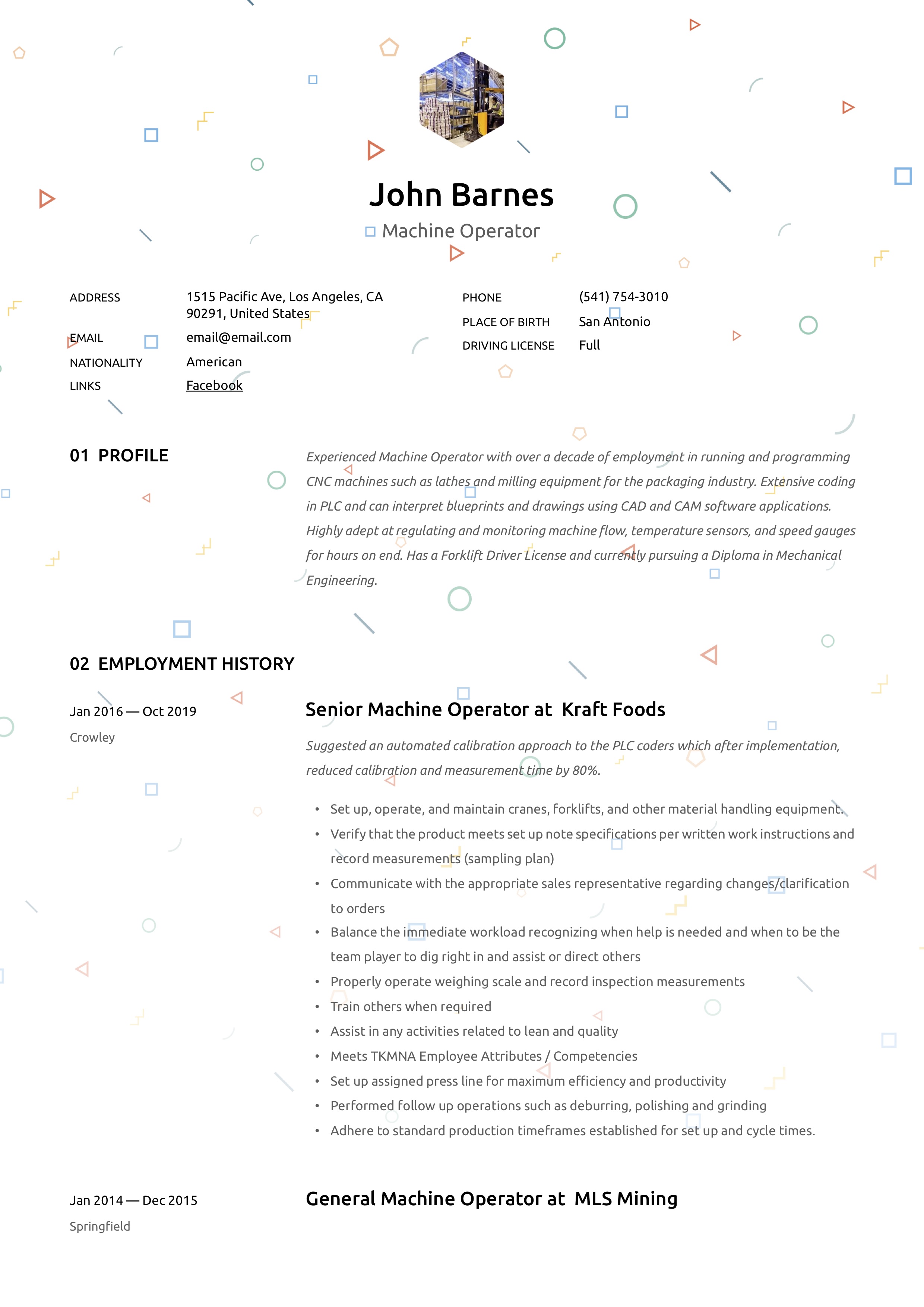
Machine Operator – Resume (7).PDF
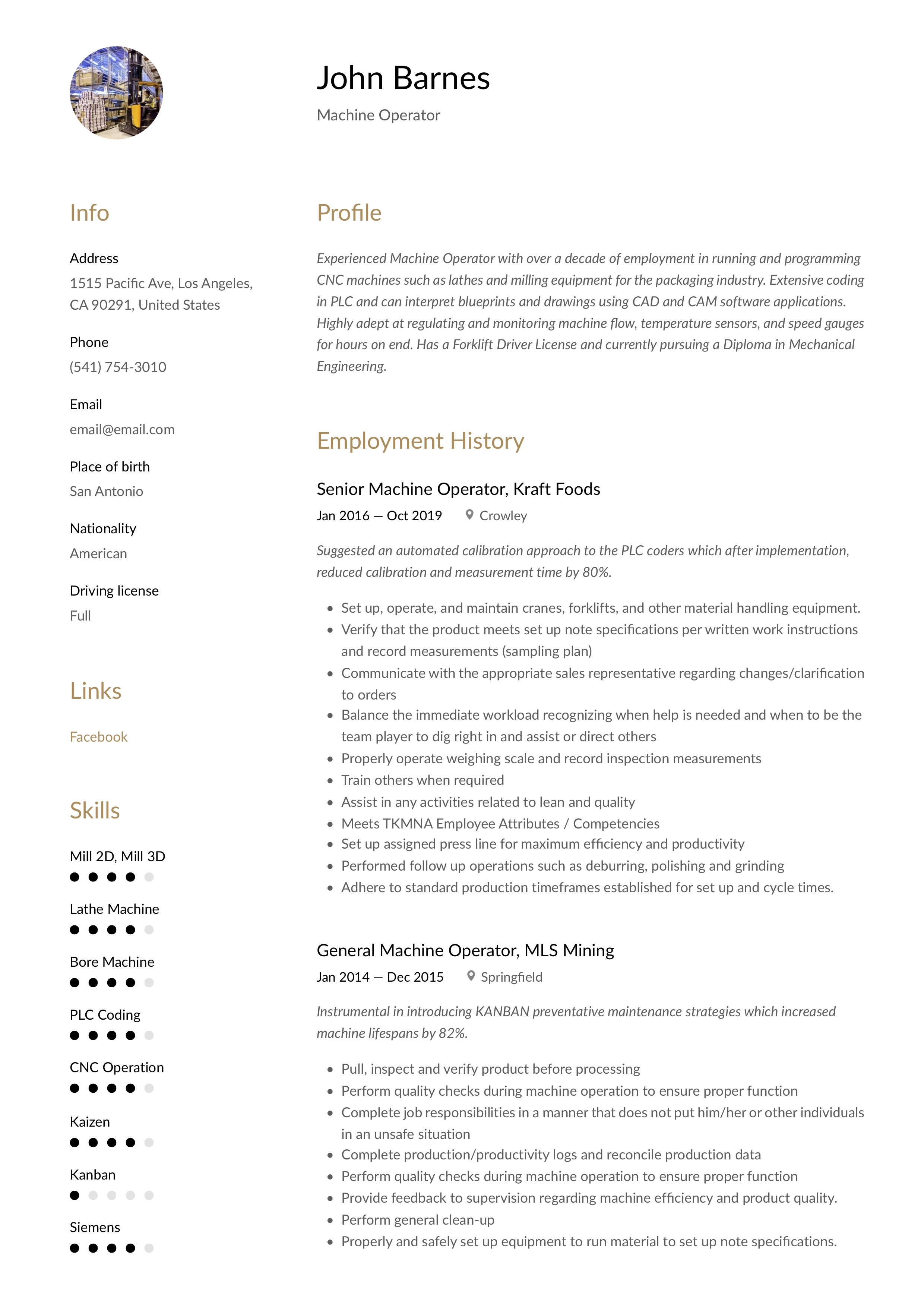
Machine Operator – Resume (8).PDF
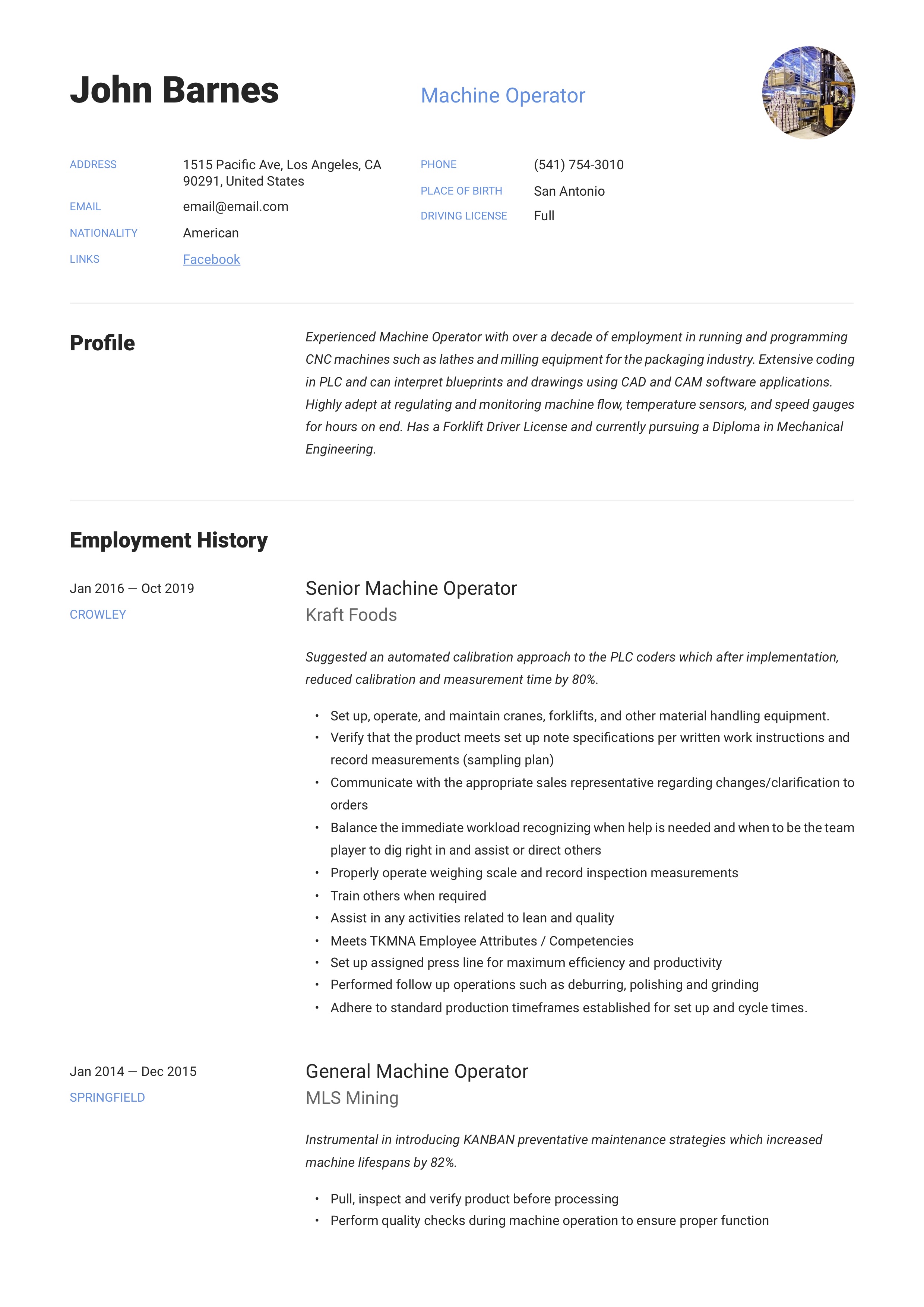
Machine Operator – Resume (9).PDF
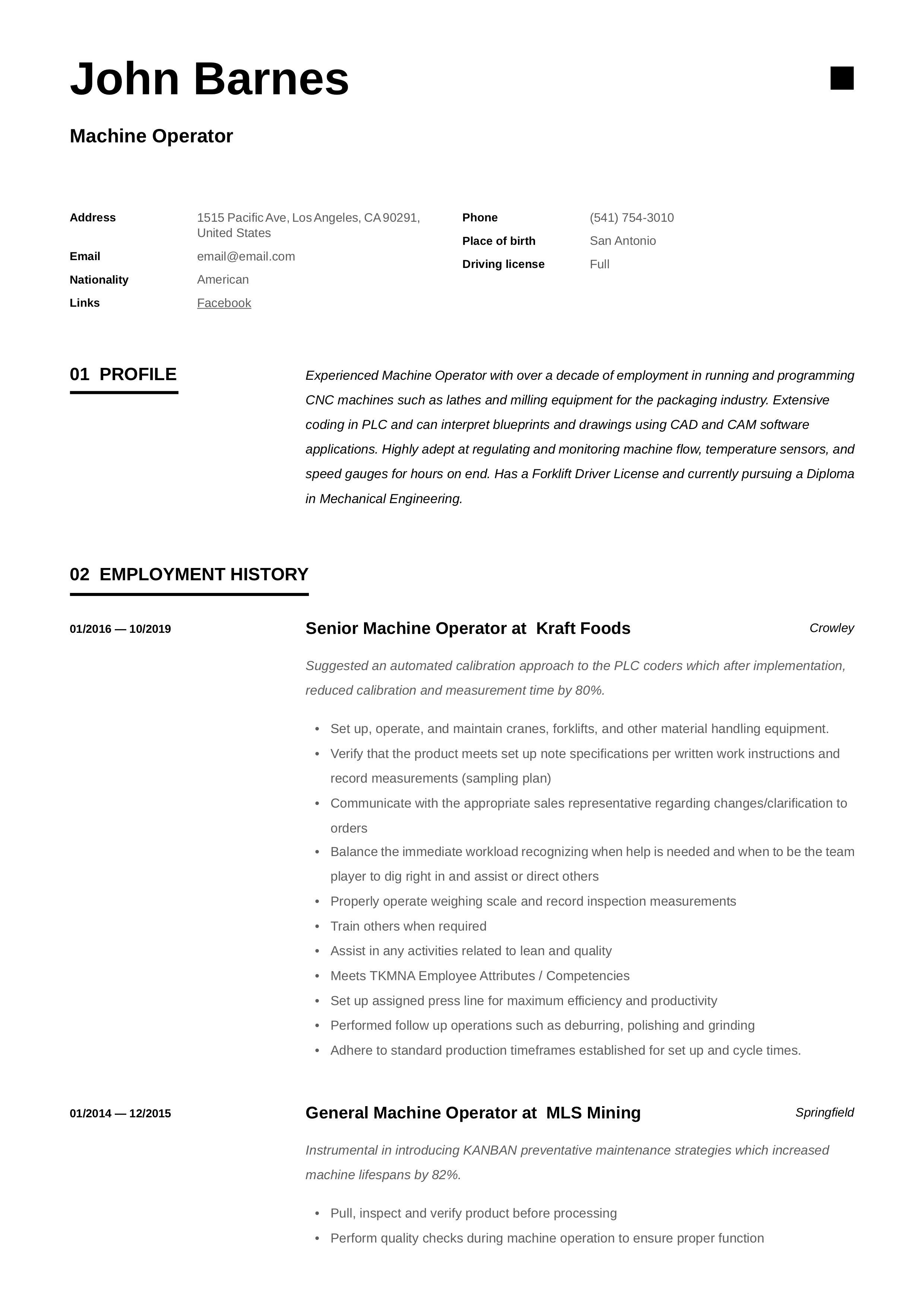
Machine Operator – Resume (10).PDF
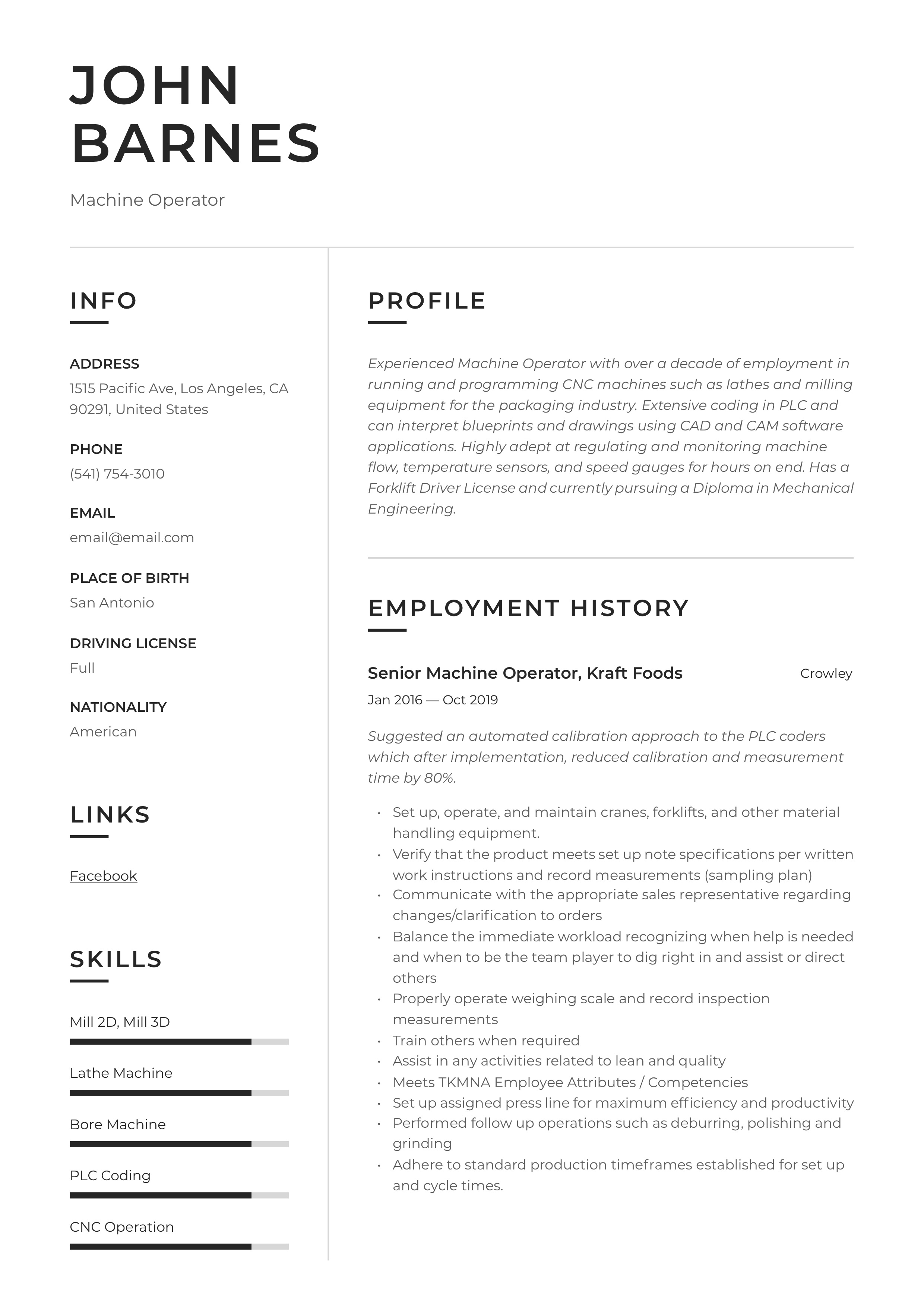
Machine Operator – Resume (11).PDF
CNC Machine Operator Resume Example
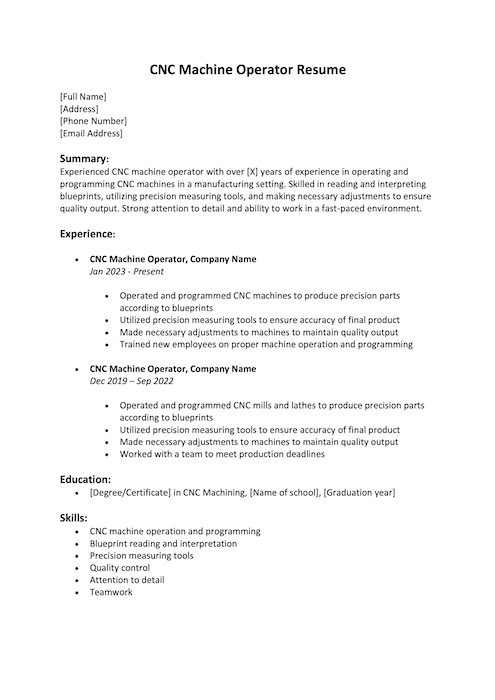
CNC Machine Operator Resume
- Made in Microsoft Word.
- Simple Design
- Download by one click (as .docx)
We recommend using the resume builder tool from Resume.io. This tool lets you effortlessly write and style your resume (and cv) without frustration.
Along the way, they provide samples to help you easily create a stunning resume.
Oh, you can use their cover letter tool for free!
